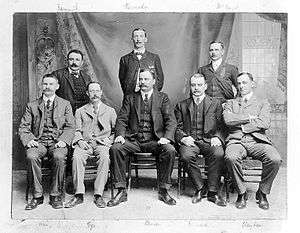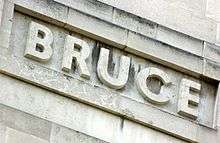David Bruce (microbiologist)
Major-General Sir David Bruce KCB FRS FRCP FRSE[1] (29 May 1855 in Melbourne – 27 November 1931 in London) was an Australian-born British pathologist and microbiologist who investigated Malta fever (later called brucellosis in his honour) and African trypanosomiasis (sleeping sickness in humans and nagana in animals). He discovered a protozoan parasite transmitted by insects, later named Trypanosoma brucei after him.[2] Working in the Army Medical Service and the Royal Army Medical Corps, his major scientific collaborator was his microbiologist wife Mary Elizabeth Bruce (née Steele), with whom he published more than thirty technical papers.[3]
Major-General Sir David Bruce | |
|---|---|
David Bruce | |
| Born | 29 May 1855 Melbourne, Australia |
| Died | 27 November 1931 (aged 76) London |
| Nationality | Scottish |
| Citizenship | British |
| Alma mater | University of Edinburgh |
| Known for | trypanosome |
| Awards | Cameron Prize for Therapeutics of the University of Edinburgh (1899) Royal Medal (1904) Leeuwenhoek Medal (1915) Buchanan Medal (1922) Albert Medal (1923) Manson Medal (1923) |
| Scientific career | |
| Fields | Microbiology |
Biography
Early life and education
Bruce was born in Melbourne, Australia to Scottish parents: engineer David Bruce (from Airth) and his wife Jane Russell Hamilton (from Stirling), who had emigrated to Australia in the gold rush of 1850. He was an only child. He returned with his family to Scotland at the age of five. They lived at 1 Victoria Square in Stirling. He was educated at Stirling High School[4] and in 1869 began an apprenticeship in Manchester. However, a bout of pneumonia forced him to abandon this and re-assess his career.[5] He then decided to study zoology but later changed to medicine at the University of Edinburgh in 1876.[6] He graduated in 1881.[7]
Medical career
After a brief period as a general practitioner in Reigate, Surrey (1881–83), where he met and married his wife Mary, he entered the Army Medical School in Hampshire at the Royal Victoria Hospital, Netley. He qualified the military examination in 1883 and joined the Army Medical Services (and served till 1919).[2] For his first post he joined the Royal Army Medical Corps in 1884 and was stationed in Valletta, Malta.[8]
Bruce was appointed Assistant Professor of pathology at the Army Medical School in Netley in 1889, and served there for five years.[7] He returned to military field service in 1894 and was posted to Pietermaritzburg, Natal, South Africa. He was assigned to investigate the case of cattle and horse sickness (called nagana) in Zululand. On 27 October 1894, he and his wife moved to Ubombo Hill, where the disease was most prevalent. When the Second Boer War broke out in 1899, accompanied by his wife, he ran the field hospital during the Siege of Ladysmith (2 November 1899 until 28 February 1900). For his service during the war he was promoted to Lieutenant-Colonel. In 1899, Bruce was awarded the Cameron Prize for Therapeutics of the University of Edinburgh. In 1900, he joined the army commission investigating dysentery in military camps, at the same time working for the Royal Society's sleeping sickness expedition.[2]
Bruce served as a member of the Army Medical Service Advisory Board from 1902 to 1911. In 1914 he became Commander of the Royal Army Medical College, the position he held until his retirement as a Major-General in 1919. He was immediately appointed chairman of the governing body of the Lister Institute. During his career he published more than ninety-seven technical articles, of which about thirty of them were coauthored by his wife.[7]
Death
He died four days after his wife in 1931, during her memorial service. Both were cremated in London and their ashes are buried together in Valley Cemetery in Stirling, close to Stirling Castle, beneath a simple stone cross on the east side of the main north-south path, near the southern roundel. They had no children.[9]
Scientific contributions

At the time of Bruce's service in Malta, British soldiers suffered an outbreak of what was called the Malta fever. In 1886, he led the Malta Fever Commission that identified the organism that caused the fever as a bacterium Micrococcus melitensis (later renamed Brucella melitensis).[10] Themistocles Zammit, one of the members of the commission, discovered the carrier of the bacillus in 1905 to be goats' milk. Bruce discouraged the experiments being carried out by Zammit, and doubted his ability as a microbiologist. Eventually, when he learned of the positive results linking the fever with unpasteurized goat milk, Bruce tried to discredit the role of Zammit and take credit to himself. To a certain extent he succeeded, as it was renamed after him as brucellosis; however, information about the role of Zammit eventually came to light.[11]
When he was transferred to South Africa, Bruce was sent to Zululand in 1894 to investigate the outbreak of cattle disease which the natives called nagana. In 1903, he identified the causative protozoan, and tsetse fly vector, of African trypanosomiasis ("sleeping sickness").[12] He was Surgeon-General for the duration of the First World War from 1914 to 1919 at the Royal Army Medical College, Millbank, London.[13]
Brucella is the genus and Brucellaceae is the family of the bacteria which was named after him, in recognition of his discoveries. Brucella melitensis is the cause of undulant fever in man and of abortion in goats. It is usually transmitted by goat's milk. Trypanosoma brucei,[14] the cause of sleeping sickness, is also named after him.
Honours and awards

Bruce was elected a Fellow of the Royal Society (FRS) in 1899. He served as editor of the Journal of the Royal Army Medical Corps between 1904 and 1908. He was the recipient of the Cameron prize of Edinburgh University in 1901. He received the Royal Society’s Royal Medal in 1904, the Mary Kingsley Medal in 1905, and the Stewart prize of the British Medical Association. He was Croonian lecturer at the Royal College of Physicians in 1915.[7] He was awarded the Leeuwenhoek Medal in 1915, created a Companion of the Bath (CB) in the 1905 Birthday Honours, knighted in 1908 and upgraded to a Knight Commander of the Bath (KCB) in 1918.[1] He was president of the British Science Association during 1924–1925.[15]
Bruce's name features on the frieze of the London School of Hygiene & Tropical Medicine. Twenty-three names of public health and tropical medicine pioneers were chosen to feature on the School building in Keppel Street when it was constructed in 1926.[16]
References
- b., J. R. (1932). "Sir David Bruce. 1855-1931". Obituary Notices of Fellows of the Royal Society. 1: 79. doi:10.1098/rsbm.1932.0017.
- Cook, G.C. (2007). Tropical Medicine: An Illustrated History of The Pioneers. Burlington (US): Elsevier Ltd. pp. 145–156. ISBN 978-0-08-055939-1.
- "Sir David Bruce". www.whonamedit.com. Ole Daniel Enersen. Retrieved 30 January 2017.
- "Bruce, Colonel David". Who's Who. Vol. 59. 1907. pp. 234–235.
- Stirling's Talking Stones ISBN 1-870-542-48-7
- "Former RSE Fellows 1783–2002" (PDF). Royal Society of Edinburgh. Archived from the original (PDF) on 4 October 2006. Retrieved 19 September 2010.
- Brown, G. H. "David (Sir) Bruce". munksroll.rcplondon.ac.uk. Royal College of Physicians of London. Retrieved 30 January 2017.
- SACHS A (October 1951). "A memorial to major-general Sir David Bruce, K.C.B., F.R.S". Journal of the Royal Army Medical Corps. 97 (4): 293–5. PMID 14889518.
- http://www.royalsoced.org.uk/cms/files/fellows/biographical_index/fells_indexp1.pdf
- Corbel, M.J.; Banai, M. (2015). "Brucella". Bergey's Manual of Systematics of Archaea and Bacteria. John Wiley & Sons. pp. 1–30. doi:10.1002/9781118960608.gbm00807.
- Wyatt, Harold Vivian (October 2005). "How Themistocles Zammit found Malta Fever (brucellosis) to be transmitted by the milk of goats". Journal of the Royal Society of Medicine. 98 (10): 451–454. doi:10.1258/jrsm.98.10.451. OCLC 680110952. PMC 1240100. PMID 16199812.
- Ellis, H. (March 2006). "Sir David Bruce, a pioneer of tropical medicine". British Journal of Hospital Medicine. 67 (3): 158. doi:10.12968/hmed.2006.67.3.20624. PMID 16562450.
- S R Christophers: 'Bruce, Sir David (1855–1931)' (rev. Helen J Power), Oxford Dictionary of National Biography, Oxford University Press, 2004; online edn, Oct 2008, accessed 23 May 2014
- Joubert, J.J.; Schutte, C.H.; Irons, D.J.; Fripp, P.J. (1993). "Ubombo and the site of David Bruce's discovery of Trypanosoma brucei". Transactions of the Royal Society of Tropical Medicine and Hygiene. 87 (4): 494–5. doi:10.1016/0035-9203(93)90056-V. PMID 8249096.CS1 maint: multiple names: authors list (link)
- Presidential Address to the British Association Meeting, held at Toronto in 1924
- "Behind the Frieze". LSHTM. Archived from the original on 3 July 2012. Retrieved 21 February 2017.
Bibliography
- Laval R E (December 2006). "Contribución al estudio histórico de la brucelosis en Chile" [A contribution to historical understanding of brucellosis in Chile]. Revista chilena de infectología (in Spanish). 23 (4): 362–6. doi:10.4067/S0716-10182006000400012. PMID 17186086.
- Pai-Dhungat JV, Parikh F (May 2004). "Sir David Bruce (1855–1931) postal stamps released to commemorate Anti-Brucellosis Congress-Malta 1964". The Journal of the Association of Physicians of India. 52: 428. PMID 15656037.
- Haas LF (April 2001). "Sir David Bruce (1855–1931) and Thermistocles Zammit (1864–1935)". Journal of Neurology, Neurosurgery, and Psychiatry. 70 (4): 520. doi:10.1136/jnnp.70.4.520. PMC 1737312. PMID 11254779.
- Vassallo DJ (September 1996). "The saga of brucellosis: controversy over credit for linking Malta fever with goats' milk". Lancet. 348 (9030): 804–8. doi:10.1016/S0140-6736(96)05470-0. PMID 8813991.
- Grogono BJ (August 1995). "Sir David and Lady Bruce. Part II: further adventures and triumphs". Journal of Medical Biography. 3 (3): 125–32. PMID 11639830.
- Freeling P (June 1995). "The Sir David Bruce Lecture, 1994. A matter of principles". Journal of the Royal Army Medical Corps. 141 (2): 61–9. doi:10.1136/jramc-141-02-02. PMID 7562740.
- Grogono BJ (May 1995). "Sir David and Lady Bruce. Part I: A superb combination in the elucidation and prevention of devastating diseases". Journal of Medical Biography. 3 (2): 79–83. PMID 11640041.
- Evans JA (1993). "Sir David Bruce: the dawn of microbiology". Veterinary History. 7 (3): 105–9. PMID 11639304.
- Carne SJ (June 1991). "Sir David Bruce Lecture 1990. "Heads and tales"". Journal of the Royal Army Medical Corps. 137 (2): 63–8. doi:10.1136/jramc-137-02-02. PMID 1875320.
- Morrell DC (June 1989). "Sir David Bruce memorial lecture 1988". Journal of the Royal Army Medical Corps. 135 (2): 43–8. doi:10.1136/jramc-135-02-02. PMID 2671356.
- Mochmann H, Köhler W (1988). "100 years of bacteriology—history of the discovery of brucellosis. 1: Uncovering the etiology of Malta fever by the British military surgeon David Bruce and the Mediterranean Fever Commission" [100 years of bacteriology—history of the discovery of brucellosis. 1: Uncovering the etiology of Malta fever by the British military surgeon David Bruce and the Mediterranean Fever Commission]. Zeitschrift für ärztliche Fortbildung (in German). 82 (6): 287–90. PMID 3043930.
- Duggan AJ (September 1977). "Bruce and the African Trypanosomes". The American Journal of Tropical Medicine and Hygiene. 26 (5 Pt 2 Suppl): 1080–3. doi:10.4269/ajtmh.1977.26.1080. PMID 20787.
- Boyd J (June 1973). "Sleeping sickness. The Castellani-Bruce controversy". Notes and Records of the Royal Society of London. 28: 93–110. doi:10.1098/rsnr.1973.0008. PMID 11615538.
- ROBERTSON M (April 1956). "Some aspects of trypanosomiasis with particular reference to the work of Sir David Bruce". The Journal of Tropical Medicine and Hygiene. 59 (4): 69–77. PMID 13332700.
- MACARTHUR W (September 1955). "An account of some of Sir David Bruce's researches, based on his own manuscript notes". Transactions of the Royal Society of Tropical Medicine and Hygiene. 49 (5): 404–12. doi:10.1016/0035-9203(55)90003-1. PMID 13267903.
- "Nova et Vetera". British Medical Journal. 1 (4925): 1337. May 1955. doi:10.1136/bmj.1.4925.1337. PMC 2062064. PMID 14363890.
- ROBERTSON M (April 1955). "Sir David Bruce: an appreciation of the man and his work". Journal of the Royal Army Medical Corps. 101 (2): 91–9. PMID 14368591.
- TULLOCH WJ (April 1955). "Sir David Bruce; an appreciation". Journal of the Royal Army Medical Corps. 101 (2): 81–90. PMID 14368590.
- DAVIES M (April 1955). "A bibliography of the work of Sir David Bruce, 1887–1924". Journal of the Royal Army Medical Corps. 101 (2): 122–9. PMID 13248207.
_2.jpg)
.jpg)
_and_wife.jpg) Bruce with wife
Bruce with wife
External links
| Wikimedia Commons has media related to David Bruce (microbiologist). |